Chardonnay
| Chardonnay | |
|---|---|
| Ideal soil | Chalk, limestone |
| Hazards | Millerandage, powdery mildew, frost and coulure |
| VIVC number | 2455 |
| Wine characteristics | |
| Cool climate | Lean, crisp, high acidity |
| Medium climate | Honey, tropical fruit |
Chardonnay (
The Chardonnay grape itself is neutral, with many of the flavors commonly associated with the wine being derived from such influences as
Chardonnay is an important component of many sparkling wines around the world, including Champagne and Franciacorta in Italy. Chardonnay's popularity peaked in the late 1980s, then gave way to a backlash among those wine connoisseurs who saw the grape as a leading negative component of the globalization of wine. Nonetheless, it is one of the most widely planted grape varieties, with 210,000 hectares (520,000 acres) worldwide, second only to Airén among white wine grapes and fifth among all wine grapes.[6]
History

For much of its history, a connection was assumed between Chardonnay and
Modern
The Pinot of the French
Clones, crossing, and mutations

As of 2006, 34
Chardonnay has served as parent to several French-American
In the 1930s, Chardonnay was crossed with a
Viticulture

Chardonnay has a wide-ranging reputation for relative ease of cultivation and ability to adapt to different conditions. The grape is very "malleable", in that it reflects and takes on the impression of its terroir and
While Chardonnay can adapt to almost all
Confusion with Pinot blanc

Due to some
France
In France, Chardonnay is the second-most widely planted white grape variety just behind
Burgundy

Chardonnay is one of the dominant grapes in Burgundy, though Pinot noir vines outnumber it by nearly a three-to-one ratio. In addition to Chablis, Chardonnay is found in the
South of the Côte d'Or are the Côte Chalonnaise and Mâconnais wine regions. The villages of
Chablis

Chardonnay is the only permitted AOC grape variety in the Chablis region, with the wines there developing such worldwide recognition that the name "Chablis" has taken on somewhat generic connotations to mean any dry white wine, even those not made from Chardonnay. The name is protected in the
Chardonnay was believed to be first planted in Chablis by the
Champagne

In the Champagne, Chardonnay is one of three major grape varieties planted in the region. It is most commonly found in the
Despite receiving the same amount of sunshine as the Chablis region, Chardonnay grapes in Champagne rarely attain full ripeness due to the mean temperature of the region being around 10 °C (50 °F), barely above the minimum average temperature needed to ripen grapes. Therefore, the Chardonnay grapes do not fully develop their fruit flavors and the still version of Champagne can taste very "un-Chardonnay"-like because of this. However, it does lessen the premium on needing to keep yields low that other wine regions battle, since not much flavor is going to develop in the grapes, anyway. Rather, the element in Chardonnay that Champagne wine-makers look for is the finesse and balance of acidity that it brings to the blend. Some flavors that can emerge from, particularly with extended time on its lees, include creamy and nuttiness with some floral notes.[8]
Other French regions
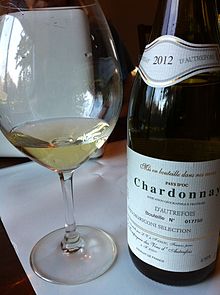
Champagne, Chablis, and Burgundy account for more than three-fifths of all Chardonnay plantings in France. The next-largest concentration is found in the
North America
In North America, particularly
California

The first successful commercial production of California Chardonnay was from plantings in the
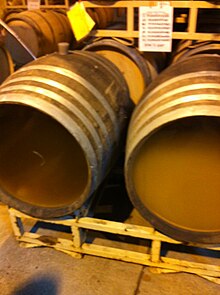
The California wine regions that seem to favor producing premium quality Chardonnay are the ones that are most influenced, climatically, by coastal
New York

Chardonnay was one of the first European grape varieties to have been grown commercially east of the Rocky Mountains. After three centuries of failure with V. vinifera, this achievement was realized in the Finger Lakes region of upstate New York. Frenchman Charles Fournier and Russian Konstantin Frank experimented with Chardonnay and other varietals in hopes of producing sparkling wines based on Old World grapes for the Gold Seal wine company. In the late 1950s, they succeeded in harvesting the first commercial quantities of European grapes in eastern North America.[18] Frank went on to found Konstantin Frank Vinifera Wine Cellars which helped demonstrate that a winery in the eastern US can produce European-style wines as a basis for a winery business. Chardonnay became an important part of that strategy.
New York, like Burgundy and Washington, is a cool-climate viticultural region. Being cold tolerant, the Chardonnay grape is well suited for New York. Not only can it endure its cold winters, but also buds late, reducing the risk of spring frosts. New York's comparatively cooler growing season causes slower ripening, requiring a longer time on the vine, which allows the grapes to develop greater complexity and character at more reasonable sugar levels than warmer Chardonnay-producing regions. New York has subsequently developed significant plantings of the variety[19] since Fournier and Frank's early experiments.
Other states
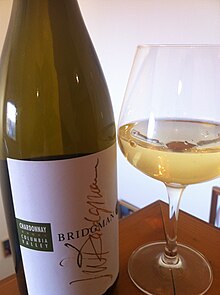
Canada
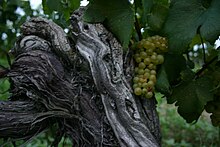
In
The Chardonnay vintages of the early 1990s from British Columbia helped generate international attention to the quality of Canadian wines apart from
Australia and New Zealand

Like many grape varieties, Chardonnay first came to

Being a rather neutral grape, Australian winemakers first approached Chardonnay in the same manner they were making wine from the similarly neutral

Despite being more famous for its Sauvignon blanc production, Chardonnay was New Zealand's most widely planted grape variety from 1990 till 2002 when Sauvignon blanc finally surpassed it. The east coast of the
Italy

Chardonnay has a long history in
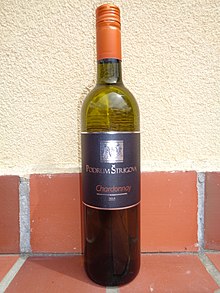
Though many varietal forms of Chardonnay are produced, and the numbers are increasing, for most of its history in Italian winemaking Chardonnay was a blending grape. Besides Pinot bianco, Chardonnay can be found in blends with
South Africa

Due to quarantine restrictions, plant
Other wine regions

Outside of the regions discussed above, Chardonnay can be found in cooler climate sites in
New World wine regions

In the cool-climate wine regions of
Winemaking
Chardonnay lends itself to almost any style of wine making from dry still wines, to sparkling wines to sweet late harvest and even
Other winemaking decisions that can have a significant effect include the temperature of fermentation and what time, if any, that the wine allowed to spend aging on the lees. Burgundian winemaking tends to favor extended contact on the lees and even "stirring up" the lees within the wine while it is aging in the barrel in a process known as bâtonnage. Colder fermentation temperatures produce more "tropical" fruit flavors like mango and pineapple.[8] The "Old World" style of winemaking favors the use of wild, or ambient yeast, though some will also use specially cultivated yeast that can impart aromatic qualities to the wine. A particular style of yeast used in Champagne is the Prise de Mousse that is cultivated for use worldwide in sparkling Chardonnay wines. A potential drawback of using wild yeast is that the fermentation process can go very slowly with the results of the yeasts being very unpredictable and producing potentially a very different wine each year. One Burgundian winemaker that favors the use of only wild yeast is Domaine des Comtes Lafon which had the fermentation of its 1963 Chardonnay batch take five years to complete when the fermentation process normally only takes a matter of weeks.[8]

The time of harvesting is a crucial decision because the grape quickly begins to lose acidity as it ripens. For sparkling wine production, the grapes will be harvested early and slightly unripe to maintain the acid levels. Sparkling Chardonnay-based wines tend to exhibit more floral and steely flavors in their youth. As the wine ages, particularly if it spends significant time on lees, the wines will develop "toasty" notes.[3] Chardonnay grapes usually have little trouble developing sugar content, even in cooler climates, which translates into high potential alcohol levels and limits the need for chaptalization. On the flip side, low acid levels can be a concern which make the wine taste "flabby" and dull. Winemakers can counteract this by adding tartaric acid in a process known as "acidification". In cooler climates, the extract and acidity of Chardonnay is magnified which has the potential of producing very concentrated wines that can develop through bottle aging.[7] Chardonnay can blend well with other grapes and still maintain some of its unique character. The grapes most often blended with Chardonnay include Chenin blanc, Colombard and Sémillon.[4]
Wine style

Due to the "malleability" of Chardonnay in winemaking and its ability to reflect its terroir, there is not one distinct universal "style" or set of constants that could be applied to Chardonnay made across the globe. According to
With food

Due to the wide range of styles, Chardonnay has the potential to be paired with a diverse spectrum of food types. It is most commonly paired with roast
Popularity and backlash

Chardonnay long had a reputation as one of France's great white wines, but due to the dominance of geographical labeling, the fact that Chardonnay was the grape behind white Burgundy was not widely known by the wine-drinking public. The success of California and new world Chardonnays, partly encouraged by the Californian showing at the Judgment of Paris wine tasting, brought varietal wine labeling to more prominence and the easy to pronounce Chardonnay grape was one of the largest beneficiaries. In the late 1980s, a sort of "Chardonnay-mania" developed as wine regions (particularly new and developing ones) dramatically increased their planting of the grape to meet the worldwide demand.[4]
As more vineyards responded with massive new plantings of the variety, they found that fashions were changing again. The market was drinking more red wine, and there was a backlash against heavy, oaky, New World Chardonnays in favor of lighter wines such as
Chardonnay became very fashionable in the 1990s, as the stereotypical drink of young urban women of the Bridget Jones generation.
By 2002, the association of Chardonnay with suburban, unsophisticated tastes was being explored in Australian TV show Kath & Kim, where lower middle class characters mispronounce the varietal as "kardonnay".
Despite the backlash, Chardonnay remains very popular. In 2004, Chardonnay was estimated to be the world's 6th most widely grown grape variety, covering 179,300 hectares (443,000 acres).[28]
Genetic modification
Currently trials are being run on
Synonyms

Due to the worldwide recognition of the name of "Chardonnay", many of these synonyms have fallen out of favor as winemakers use the more marketable Chardonnay:[7]
Arboisier, Arnaison blanc, Arnoison, Aubain, Aubaine, Auvergnat blanc, Auvernas, Auvernas blanc, Auvernat blanc, Auxeras, Auxerras blanc, Auxerrois blanc, Auxois, Auxois blanc, Bargeois blanc, Beaunois, Biela Klevanjika, Blanc de Champagne, Blanc de Cramant, Breisgauer Suessling, Breisgauer Sussling, Burgundi Feher, Chablis, Chardenai, Chardenay, Chardenet, Chardennet, Chardonay, Chardonnet, Chatenait, Chatey Petit, Chatte, Chaudenay, Chaudenet, Chaudent, Clävner, Clevner Weiss, Cravner, Epinette, Epinette blanc, Epinette blanche, Epinette de Champagne, Ericey blanc, Feher Chardonnay, Feherburgundi, Feinburgunder, Gamay blanc, Gelber Weissburgunder, Gentil blanc, Grosse Bourgogne, Klawner, Klevanjka Biela, Klevner, Lisant, Luisant, Luizannais, Luizant, Luzannois, Maconnais, Maurillon blanc, Melon blanc, Melon D'Arbois, Meroué,[7] Moreau blanc, Morillon blanc, Moulon, Noirien blanc, Obaideh, Petit Chatey, Petit Sainte-Marie, Petite Sainte Marie, Pineau blanc, Pino Sardone, Pino Shardone, Pinot Blanc à Cramant, Pinot Blanc Chardonnay, Pinot Chardonnay, Pinot de Bourgogne, Pinot Giallo, Pinot Planc, Plant de Tonnerre, Romere, Romeret, Rouci Bile, Rousseau, Roussot, Ruländer Weiß, Sainte Marie Petite, Sardone, Shardone, Shardonne, Später Weiß Burgunder, Weiß Burgunder (normally refers to Pinot blanc), Weiß Clevner, Weiß Edler, Weiß Elder, Weiß Klewner, Weiß Silber, Weißedler, Weißer Clevner, Weißer Rulander.[11]
See also
References
- ISBN 978-1-4058-8118-0.
- ISBN 978-0-521-15255-6.
- ^ ISBN 0-7892-0883-0.
- ^ a b c d e f g h i j k l m n o p q r s t u v w Robinson, 2006, pp. 154–56.
- ISBN 9781905819157.)
{{cite book}}: CS1 maint: location missing publisher (link - ^ "Distribution of the World's Grapevine Varieties" (PDF). oiv.int. International Organisation of Vine and Wine. 2018-02-28. Archived from the original (PDF) on 2018-03-01. Retrieved 2018-03-01.
- ^ ISBN 1-85732-999-6.
- ^ a b c d e f g h i j k l m n o p q r s t u v Clarke, 2001, pp. 63-73.
- ^ "Chardonnay – Wine International Association WIA". Retrieved 2024-03-17.
- ^ Clarke, 2001, pg 112
- ^ a b Maul, Erika; Töpfer, Reinhard; Eibach, Rudolf (2007). "Vitis International Variety Catalogue". Institute for Grapevine Breeding Geilweilerhof (IRZ), Siebeldingen, Germany. Retrieved 2007-10-19.
- ISBN 978-1-846-14446-2.
- ^ J. Cox & G. Gigli "Vine Identification – A Botanist's View Archived 2007-11-24 at the Wayback Machine", The Wine News Magazine, accessed January 11, 2008.
- ^ a b Robinson, 2006, pp. 148–149.
- ISBN 0-671-68702-6.
- ^ Appellation America Chardonnay Accessed: January 10, 2008.
- ^ Robinson, 2006, p. 128.
- ISBN 0-306-47272-4.
- ^ WinesNY New York Chardonnay Accessed: May 31, 2009.
- ^ ISBN 1-55868-503-0.
- ISBN 1-55143-061-4.
- ^ Radden, Rosemary. "Grapes and Wines of the World". State Library of South Australia. Archived from the original on 2007-08-07. Retrieved 2007-06-16.
- ^ Tyrell's Wines Murray Tyrell-Biography Archived 2007-12-23 at the Wayback Machine, accessed: January 12, 2007.
- ^ "Diacetyl". E.coli Metabolome Database. ECMDB. Retrieved 20 October 2013.
- ^ D. Sogg "White Wines, New Barrels: The taste of new oak gains favor worldwide Archived 2008-11-22 at the Wayback Machine" Wine Spectator. July 31, 2001.
- ^ Prial, Frank J. (1995-08-30). "Wine Talk". The New York Times.
- ^ Clarke, 2001, Websters, p. 191.
- ^ Robinson, 2006, p. 746, entry Vine varieties.
- ^ Uhlig, Robert (2001-05-31). "GM grapes could cut the price of Chardonnay". The Daily Telegraph. London. Archived from the original on 2010-06-01. Retrieved 2010-04-28.
- ^ Independent Newspapers Online (2009-08-12). "Government OKs genetically modified vines". IOL.co.za. Retrieved 2011-05-22.
Sources
- Robinson, Jancis, ed. (2006). ISBN 0-19-860990-6.
- ISBN 0-15-100714-4.
